General
Germany, located in the heart of Europe, is a country with a rich history and diverse culture. It has a population of more than 83 million people, making it the most populous country in the European Union. The population is generally well-educated, and the standard of living is high. Agriculture still plays an important role in the rural economy, combining modern technologies with traditional practices.
Germany consists of sixteen federal states, each with its own unique characteristics and culture. These are some of the most important states.
Bavaria (Bayern)
Located in the southeast of Germany, Bavaria is known for its beautiful landscapes, traditional villages, and rich history. It is also an important agricultural region with vast fields and farms. Bavaria generally hosts the largest number of arable farms in Germany. The state is known for its extensive farmland and favorable climatic conditions for the cultivation of various crops. Bavarian farms grow a wide range of crops, including grains, potatoes, sugar beets, and corn.
North Rhine-Westphalia (Nordrhein-Westfalen)
As the most densely populated state in Germany, North Rhine-Westphalia is home to major cities such as Cologne, Düsseldorf, and Dortmund. It is an important industrial center, but rural areas also play a significant role, with many farms.
Lower Saxony (Niedersachsen)
With its vast plains and fertile lands, Lower Saxony is a key agricultural region. In addition to agriculture, this state boasts beautiful nature, including the Wadden Sea area, which is a UNESCO World Heritage site. Furthermore, Lower Saxony hosts the most dairy farms in Germany.
Baden-Württemberg
This state in southwest Germany is known for its innovation and technology, as well as its traditional villages and vineyards. The agricultural sector here is advanced and focused on sustainability.
Germany's population is not only concentrated in large cities but spread across the entire country, from the North Sea coasts to the Bavarian Alps. This diversity is also reflected in the agricultural sector, where traditional practices combine with modern technologies to meet the needs of a growing population and a changing climate.
Sports
Sports play an important role in German society. Soccer is by far the most popular sport. Other sports like hockey, handball, and athletics are also widely popular.
Economy
Germany remains one of the world's largest and most advanced producers of various goods, including iron, steel, coal, cement, chemicals, machinery, vehicles, tools, electronics, food and beverages, shipbuilding, and textiles. Despite its strong industrial production, Germany is relatively poor in natural resources. Although it has significant reserves of hard coal and lignite, Germany largely imports oil and natural gas. Other mineral resources are extracted in limited quantities.
Politics
Germany is a federal republic with a democratic system. The country is governed by a chancellor and a parliament, the Bundestag. At the regional level, there are state governments with various powers.
Education
As in the Netherlands, school attendance is compulsory in Germany, starting at the age of six. Children are required to attend school for at least nine years, followed by three years of vocational training. The responsibility for education largely lies with the state governments, meaning that education systems can vary from region to region. Overall, most of the education in Germany is free of charge.
Agriculture
Germany has a lot of fertile land. Due to the favourable climate, this land is well-suited for agriculture. The agricultural sector produces about two-thirds of the food needed in Germany. The most common crops grown are potatoes, rye, rapeseed, sugar beets, wheat, cabbage, and grapes. German wines and beers are beloved and are exported to countries all over the world.
Large-scale dairy farms
Dairy farms in the east of Germany are much larger in scale than those in the Netherlands. Feed costs and milk prices are similar to those in the Netherlands. In western Germany, most farms are family-owned, similar to the Netherlands, but their structure is different. Farms have relatively more land, which makes it easier to farm extensively and comply with regulations from Brussels.
The most common breed of dairy cow in Germany is the Holstein-Friesian. This breed is known for its high milk production and adaptability to different climatic conditions.
Climate
The climate in Germany generally ranges from temperate to continental, with influences from the Atlantic Ocean in the west and the Alps in the south. In the north and west of Germany, there is a maritime climate, characterized by mild winters and cool summers, with regular rainfall throughout the year. Toward the east, the climate becomes more continental, with greater temperature differences between summer and winter and less rainfall. In southern Germany, especially in the regions around the Alps, there is a mountain climate with cold winters and warm summers, and significant precipitation, mainly in the form of snow in the winter months.
Precipitation
Precipitation in Germany varies greatly depending on the region and season. Generally, the western and northern parts of the country receive more than the eastern and southern regions. On average, between 600 and 1200 millimeters are recorded annually, with higher amounts in mountainous areas and along the coasts.
Sunshine hours also differ by season and region. In the summer months, parts of Germany can expect an average of 6 to 8 hours of sunshine per day, while the winter months generally have fewer sunshine hours, averaging between 1 and 4 hours per day.
Social affairs
Since October 3, 1990, the social security laws of West Germany have applied to the whole country, leading to a uniform approach to social services across the nation, including healthcare, medications, hospital costs, maternity expenses, and home care. The financing of social services is largely shared between employers and employees, with employers paying social security contributions, which are deducted from the employees' income. Since January 1, 1992, a mandatory pension insurance has been in place in eastern Germany, aimed at ensuring an adequate pension, with the costs shared by employees and employers.
In Germany, farmers are required to have four types of insurance:
- Health insurance: This insurance covers medical expenses, medications, hospitalisations, maternity costs, and home care for farmers.
- Pension insurance: Farmers are required to participate in a pension insurance scheme, with costs shared between employees and employers.
- Accident insurance: This insurance provides coverage for accidents that occur during work-related activities on the farm.
- Unemployment insurance: Farmers are required to contribute to unemployment insurance, which provides income support in the event of unemployment.


